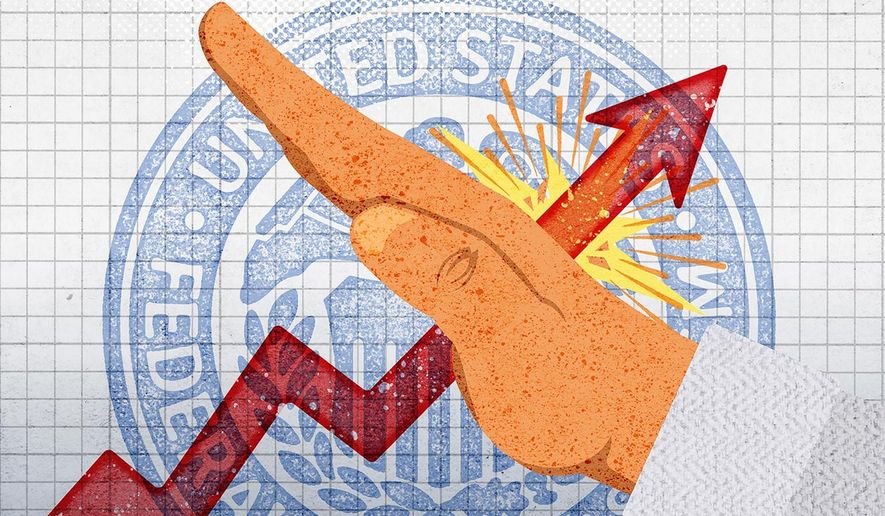OPINION:
Inflation makes you rich — well, not exactly — but it can make you appear rich. As a teenager, did you dream of having a $100,000 car and a million-dollar home? A few more years of the present rate of inflation, that will be the norm for most people (at today’s over 7% inflation, the value of the dollar is cut in half every 10 years — meaning today’s $50,000 car will be $100,000 in 2032).
Before the Federal Reserve went into operation in 1914, the average price level had barely changed since Alexander Hamilton was secretary of the treasury in 1790. In real terms, most goods and services had fallen in price because of the huge gain in productivity during the Industrial Revolution. The inventions of the steam engine and the electric motor totally changed the nature of work for most people. People went from living a subsistence level or a little better to having some luxuries, including free time, for the first time in human history.
The Fed has the responsibility for maintaining a stable price level. How well have they done? It now takes about $29 to buy what $1 would have in 1914. The average price level has increased by about 11 times just since 1955. In 1955, bananas were 17 cents, white bread was 18 cents, and potatoes were 5.6 cents per pound. Toilet paper was 9 cents a roll, a man’s business shirt was $3.95, a man’s haircut was $1.42, and a gallon of gasoline was 29 cents.
Inflation has an uneven impact. Those with unique skills that are in high demand — such as software engineers, or exceptional athletes, or entertainers — are often able to obtain salary increases to more than offset inflation. For low-skilled people, the opposite is true. For people living on fixed incomes, including many retirees, inflation can be brutal.
What causes inflation? Assume that most of the people in an isolated town that has its own fiscal and monetary policies, including the creation of its own money, agree that a new bridge needs to be built over the river. The bridge is estimated to cost $10 million. It can be financed by an increase in local taxes, such as the property tax or by making it a toll bridge, or by the issuance of debt not financed by new taxes or user fees. Many people like “free stuff” (even though there is no such thing), so they opt for a sale of 30-year bonds not covered by new taxes or tolls. The town has a good credit rating, so the bonds sell quickly. The townspeople notice that they have a nice new bridge, but don’t have to worry about paying for it, other than modest interest payments each year. And in 30 years, when the bonds are due, they will be retired in Florida and there will be a new set of town managers.
Increasingly, the people opt for unsecured bond financing rather than increasing taxes or user fees to cover the costs of operating the town. One day, the Wall Street banker who has been selling the town’s bonds, says to the locals, “my colleagues notice you have too much debt to service the interest and principal on all the bonds that have been issued, so we are going to have to greatly increase the interest rate and not buy any more of the town’s bonds.”
The town’s leaders are distressed to hear the bad news, but quickly realize that since the town creates its own money, they merely have to tell their money-issuing bank to print more money to cover the increased debt service costs. The Wall Street banker protests, noting that no new goods and services have been produced to offset the new money creation, so each unit of money will be worth less.
All of this leaves the town’s bondholders in a bind because they agreed to receive their interest and principal in the town’s money rather than gold, silver, aluminum or some other commodity of real value. All of those individuals, institutions, and foreign governments holding U.S. government bonds now find themselves in a similar bind, because they are going to receive payment in devalued dollars. The U.S. economy will continue to chug along — at a slower rate or even a negative rate for a period — but the nominal, as contrasted with real or inflation-adjusted numbers, will grow. The result is that the debt as a percentage of GDP will fall (provided the government does not add new net debt) until the cost of servicing the debt is back to a level that the markets view as sustainable.
In sum, the quick way to get rid of inflation is stop any new deficit spending, and allow interest rates to rise to a level that the market views as sufficient to service the existing debt. Once fiscal policy is viewed as sound and sustainable, interest rates should fall — without Fed intervention — and the economy will nicely grow in real terms.
If deficits and counterproductive regulation continue, the inflation and economic stagnation will also continue. The destiny of the world and the U.S. economy is not in the stars, but in the hands of the economic policymakers.
• Richard W. Rahn is chairman of the Institute for Global Economic Growth and MCon LLC.




Please read our comment policy before commenting.